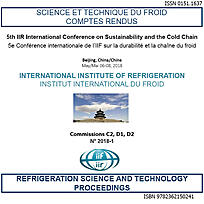
Document IIF
Étude expérimentale sur l’utilisation d’une cuve de refroidissement pour du saumon péché en Atlantique.
Experimental investigation of chilling tank for atlantic salmon.
Numéro : pap.43
Auteurs : WIDELL K. N., NORDTVEDT T. S., TOLSTOREBROV I., et al.
Résumé
Farmed salmon is a large export product from Norway. After the salmon is stunned and killed, it istransported to large tanks for bleeding, chilling and buffering before gutting and further processing. The temperature of the fish into the processing plant is varying, but it is necessary to cool down the fish fast, both to reduce bacterial growth and to maximize yield. In this paper, the chilling process in salmon specimens are investigated. The temperatures in both salmon and cooling water (RSW) were measured. All the fish was chilled by 1.0 to 3.2 °C during the stay in the tank. There are several possible reasons for the temperature variations. For examples varied the fish temperature into the tank from one test to another, the flow through the processing system varied (mainly because of technical issues in other parts) and the refrigeration system could not always provide RSW at the required temperatures. The main goal is to have more even and larger temperature differences, and to achieve that the focus should first be on the RSW system (both refrigeration system and the water pipes and components) and to ensure that it works properly.
Documents disponibles
Format PDF
Pages : 9
Disponible
Prix public
20 €
Prix membre*
Gratuit
* meilleur tarif applicable selon le type d'adhésion (voir le détail des avantages des adhésions individuelles et collectives)
Détails
- Titre original : Experimental investigation of chilling tank for atlantic salmon.
- Identifiant de la fiche : 30023397
- Langues : Anglais
- Source : 5th IIR International Conference on Sustainability and the Cold Chain. Proceedings: Beijing, Chine, 6-8 avril 2018
- Date d'édition : 06/04/2018
- DOI : http://dx.doi.org/10.18462/iir.iccc.2018.0043
Liens
Voir d'autres communications du même compte rendu (72)
Voir le compte rendu de la conférence
Indexation
-
Thèmes :
Réfrigération des aliments;
Poissons et produits de la mer - Mots-clés : Industrie alimentaire; Température; Réservoir; Refroidissement; Saumon; Norvège; Experimentation
-
Challenges of effective chilling of Atlantic sa...
- Auteurs : TOLSTOREBROV I., WIDELL K. N., NORDTVEDT T. S., et al.
- Date : 24/08/2019
- Langues : Anglais
- Source : Proceedings of the 25th IIR International Congress of Refrigeration: Montréal , Canada, August 24-30, 2019.
- Formats : PDF
Voir la fiche
-
Chilled and frozen Atlantic salmon: Environment...
- Auteurs : REDO M. A., CHE M., WATANABE M., TOLSTOREBROV I.
- Date : 11/06/2024
- Langues : Anglais
- Source : 8th IIR International Conference on Sustainability and the Cold Chain. Proceedings: June 9-11 2024
- Formats : PDF
Voir la fiche
-
Chilling of pelagic fish onboard Norwegian fish...
- Auteurs : NORDTVEDT T. S., WIDELL K. N.
- Date : 24/08/2019
- Langues : Anglais
- Source : Proceedings of the 25th IIR International Congress of Refrigeration: Montréal , Canada, August 24-30, 2019.
- Formats : PDF
Voir la fiche
-
Study of convective heat transfer and chilling ...
- Auteurs : TOLSTOREBROV I., EIKEVIK T. M., WIDELL K. N., et al.
- Date : 24/08/2019
- Langues : Anglais
- Source : Proceedings of the 25th IIR International Congress of Refrigeration: Montréal , Canada, August 24-30, 2019.
- Formats : PDF
Voir la fiche
-
Sub-chilling of head-on gutted Atlantic salmon ...
- Auteurs : ROTABAKK B. T., VANGEN E., LERFALL J.
- Date : 11/06/2024
- Langues : Anglais
- Source : 8th IIR International Conference on Sustainability and the Cold Chain. Proceedings: June 9-11 2024
- Formats : PDF
Voir la fiche
